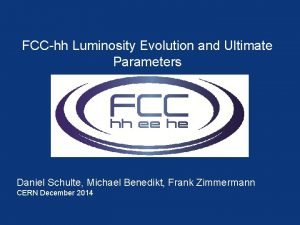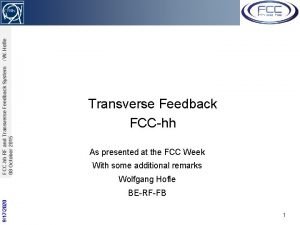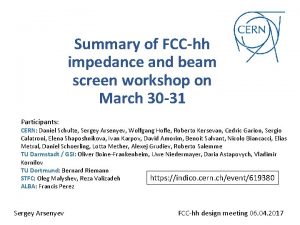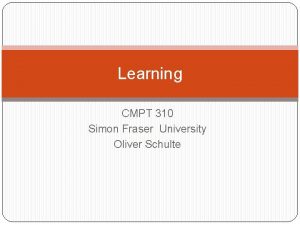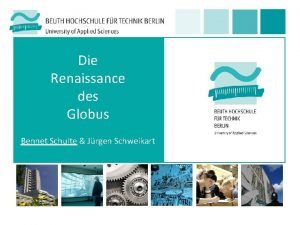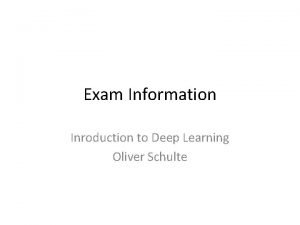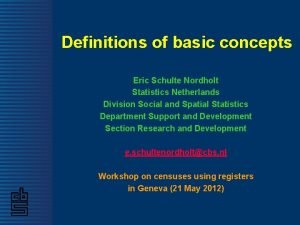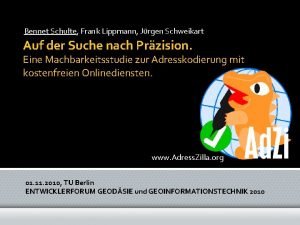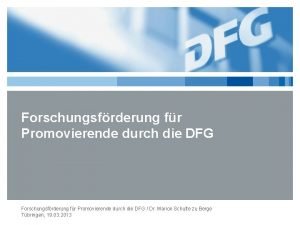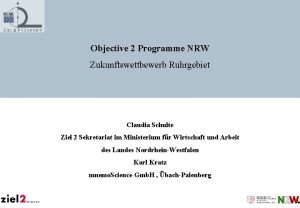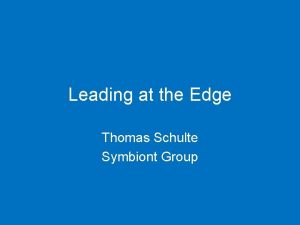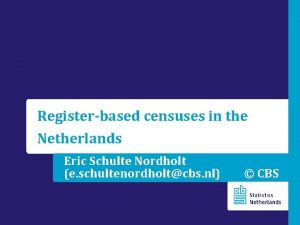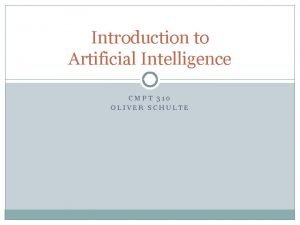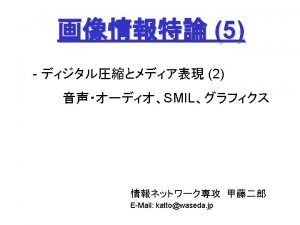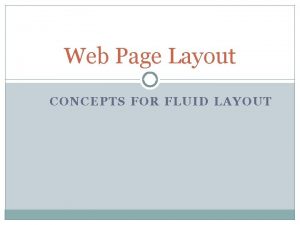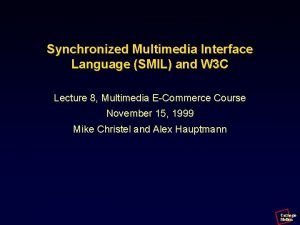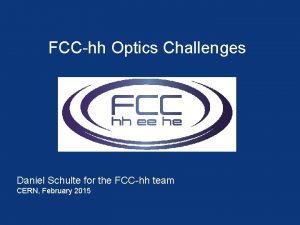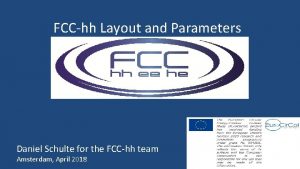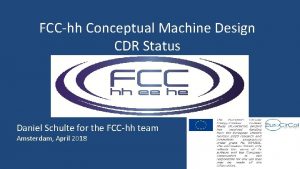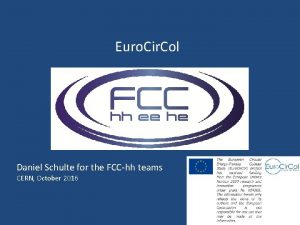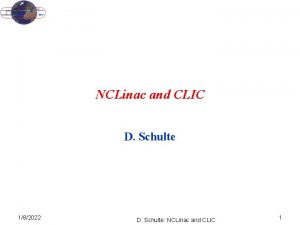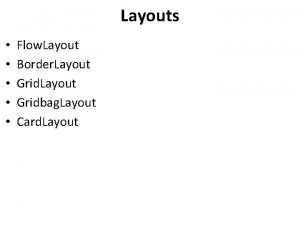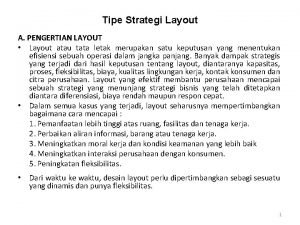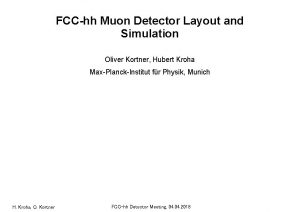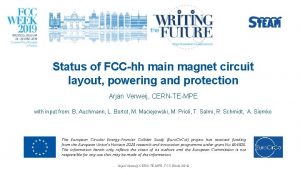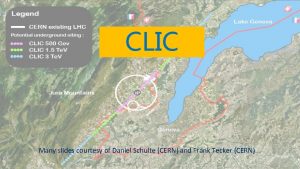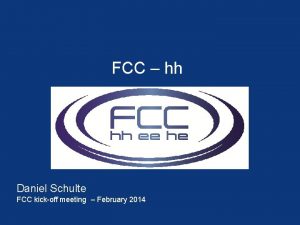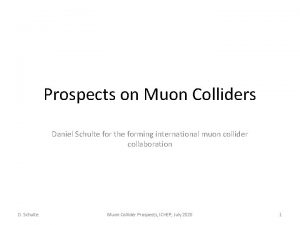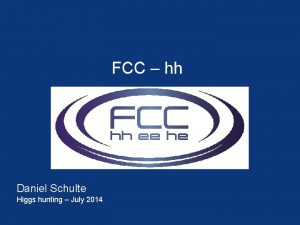FCChh Layout Daniel Schulte for the FCChh team



































- Slides: 35

FCC-hh Layout Daniel Schulte for the FCC-hh team CERN, June 2015

FCC-hh Goal and Parameters House two main and two additional experiments • For baseline will run all experiments • For ultimate parameters may run main experiments only Use dipole magnets of up to 16 T Assuming 80% dipole filling factor in arcs we need about 82 km of arcs Circumferences considered: 3. 0, 3. 25, 3. 5 3. 75, 4. 0 LHC circumference Could use many other values 3. 75 corresponds to C=99. 971 km D. Schulte CMS energy [Te. V] Luminosity [1034 cm-2 s-1] Baseline Ultimate 100 5 20 Bunch distance [ns] Background events/bx 25 (5) 170 (34) 680 (136) Bunch charge [1011] 1 (0. 2) Norm. emitt. [mm] 2. 2(0. 44) RMS bunch length [cm] IP beta-function [m] 8 1. 1 0. 3 IP beam size [mm] 6. 8 (3) 3. 5 (1. 6) Max ξ for 2 IPs 0. 01 (0. 02) 0. 03 Euro. Cir. Col Workplan, CERN, June 2015 2

Preliminary Layout First layout developed • Two high-luminosity experiments (A and G) • Two other experiments (F and H) • Two collimation/extraction insertions • Two injection insertions, should include RF • Insertion lengths are based on first order designs or even estimates, will be reviewed as optics designs are made D. Schulte Euro. Cir. Col Workplan, CERN, June 2015 3

Insertion Lengths Insertion Length Exp 1 1. 4 km Exp 2 1. 4 km Exp 3 1. 4 km Exp 4 1. 4 km Inj 1 1. 4 km Inj 2 1. 4 km Coll 1 2. 8 km Coll 2 2. 8 km Extr 1 1. 4 km Extr 2 1. 4 km Insertion lengths are based on first order designs or even estimates, will be reviewed as optics designs are made D. Schulte Euro. Cir. Col Workplan, CERN, June 2015 4

Insertion Length Scaling LD, 0 LQ= r x LQ, 0 LD= r x LD, 0 For use of same technology, scale all lengths by r=2. 67 Typical insertion length L≈1400 m D. Schulte Euro. Cir. Col Workplan, CERN, June 2015 5

High-luminosity Insertions The allocated length is consistent with the required performance • Achieve beta-function goal • Provide less beam stay clear than HL-LHC • Pushed beta-function • More shielding in magnet Collimation system • Hopeful to be able to handle radiation into the final triplet • Enough space for the detector Do currently not expect large variations of the required length D. Schulte Euro. Cir. Col Workplan, CERN, June 2015 6

Betatron Collimation Need to adapt to smaller beam stay clear in experiment triplets Secondaries from showers in primary collimators will be much harder to catch • smaller scattering angles • more energy in showers Optics scaling from HL-LHC: r. C =(50 Te. V/7 Te. V)1/2 x 0. 4 m/0. 3 m x (59 mm/49 mm)2 => r. C ≈ 5. 2 ≈ 2 r Normal scaling (r) => LC=2. 8 km IP beta-function (increases beta-function in triplets) Aperture reduction due to shielding Have a scaled lattice of 2. 7 km • seems to give adequate inefficiencies • gaps are consistent with experimental insertion beam stay clear Now need to verify the performance • In particular for secondaries D. Schulte Euro. Cir. Col Workplan, CERN, June 2015 7

Energy Collimation Assume that FCC-hh beam energy spread is similar to LHC beam energy spread The scaled HL-LHC energy collimation system provides sufficient dispersion at the primary collimators for FCC-hh 1. 4 km could be sufficient But need to understand the secondaries Might need more length Need 1. 4 to 2. 8 km D. Schulte Euro. Cir. Col Workplan, CERN, June 2015 8

Injection Insertions Miss-kicked beam at injection is an issue Sufficient space for injection optics But protection against secondaries needs to be studied Integration of RF needs to be studied D. Schulte LHC FCC-hh Kick angle [mradian] 0. 85 0. 29 Integrated field [Tm] 1. 3 3. 2 MKI length [m] 10. 6 <120 Rise time [ns] 900 280 Euro. Cir. Col Workplan, CERN, June 2015 9

Extraction Insertions One of the main challenges • Beam loss on septa and lattice components during beam sweep in case of failure Three different designs are being investigated • 1. 4 km space allocation seems consistent with optics requirements • But failure requires more study More space would be beneficial • Consider combination with collimation system • Try to take advantage of space in non-extracted beam lattice D. Schulte Euro. Cir. Col Workplan, CERN, June 2015 10

More Detailed Layout Two main experiments on opposite sides of the collider • Ensures that all bunches collider in main experiments • Other wise luminosity is reduced • And ultimate performance due to differences between colliding and non-colliding bunches (e. g. abort gap) D. Schulte Euro. Cir. Col Workplan, CERN, June 2015 11

More Detailed Layout The additional experiments and the injection lines are separated • Adds two insertions compared to LHC • Preferable for operational freedom Could consider additional experiments to be in L and B, if injection into experiment is allowed D. Schulte Euro. Cir. Col Workplan, CERN, June 2015 12

More Detailed Layout The injection insertion position is determined by LHC, if used as injector D. Schulte Euro. Cir. Col Workplan, CERN, June 2015 13

More Detailed Layout The additional experiments should be close to one of the main experiments to form a cluster The experiments are separated by at least about 1600 m of arc • To avoid background from one experiment into the other • This distance will be reviewed by the Euro. Cir. Col MDI activity Additional experiments respect mirror symmetry • To guarantee same path length for both beam Note: non-colliding bunches should no concern, since experiments will not be used for ultimate performance D. Schulte Euro. Cir. Col Workplan, CERN, June 2015 14

More Detailed Layout Assume symmetry of injection and additional experiment insertions • This could be modified if important D. Schulte Euro. Cir. Col Workplan, CERN, June 2015 15

More Detailed Layout RF should be inserted in injection lines (on noninjected beam) • Do not foresee RF insertion • Injection appears smallest radiation risk D. Schulte Euro. Cir. Col Workplan, CERN, June 2015 16

More Detailed Layout Foresee two collimation and extraction insertions • Insertions with largest risk • Scheme provides flexibility D. Schulte Euro. Cir. Col Workplan, CERN, June 2015 17

More Detailed Layout The two beams are extracted in two different parts of an insertion (or two different insertions) • To ease this very difficult task and give more freedom to the hardware design Could be both lines on one side or on different sides D. Schulte Euro. Cir. Col Workplan, CERN, June 2015 18

More Detailed Layout Long space after extraction allows to deal with failure debris But collimators/absorbers there will add impedance • Similar to betatron collimation D. Schulte Euro. Cir. Col Workplan, CERN, June 2015 19

More Detailed Layout Potentially advantageous to have the betatron collimation after the extraction insertion • To protect the machine from badly extracted beam D. Schulte Euro. Cir. Col Workplan, CERN, June 2015 20

More Detailed Layout Could consider using the energy collimation after the extraction for machine protection The current layout with the long collimation/extraction insertions provides flexibility to address the issues of the collimation and extraction insertions Do we need to fix now if both extraction lines are in the same ESS? Would like to keep the flexibility D. Schulte Euro. Cir. Col Workplan, CERN, June 2015 21

Dimensions Type No Length LSS 6 1. 4 km ESS 2 4. 2 km TSS 4 ? DIS 16 0. 4 km SAR 4 1) Injection 2) Experiment separation 3) Lattice LAR 4 LSS LAR DIS LSS SAR DIS DIS SAR LSS DIS LAR TSS LAR DIS ESS calculated DIS are assumed to have 75% of the bending (4/3) the radius of the arcs DIS ESS DIS LAR TSS LAR DIS LSS D. Schulte DIS DIS LSS SAR DIS SAR Euro. Cir. Col Workplan, CERN, June 2015 LAR 22

Arc Layout Cell length is a trade-off Preliminary example design: 12 dipoles with L=14. 3 m Lcell=214. 755 m Fill factor about 80% Field to reach 100 Te. V with 100 km ring is very close to 16 T Note: TSS etc. will increase required field 93 km tunnel would reach 45 Te. V/beam with 16 T More work is neededdipoles to finalise optics A. Chance, B. Dalena, J. Payet, B. Holzer D. Schulte Euro. Cir. Col Workplan, CERN, June 2015 23

Non-Planar Design There is no obvious fundamental obstacle for a non-planar design • Assuming one kink in the vertical plane But some non-dispersive bending system is required • Typical implementation is • Horizontal dispersion suppressor • Vertical bend • Vertical dispersion suppressor • Horizontal dispersion suppressor • This takes space (minimum is 2 x 800 m for vertical dispersion suppressors) • Will reduce the overall dipole filling factor Would need to study details D. Schulte Euro. Cir. Col Workplan, CERN, June 2015 24

Conclusion We have chosen one layout to have a basis for our work We do not have a full lattice design • Working on filling the gaps: collimation system, integration of RF, extraction lines, separation between experiments, … The proposed layout is best guess for the lattice design • Experiment insertions seem solid • Work on best configuration for ESS (collimation and extraction) • Risk from high energy is most important in these lines • But current design has great flexibility • Extractions in one or two ESS to be defined • Will try to compress the ESS if possible 100 km circumference and 16 T dipoles are required for 100 Te. V cms. A non-planar design can be considered but will reduce the overall dipole filling factor D. Schulte Euro. Cir. Col Workplan, CERN, June 2015 25

Reserve D. Schulte Euro. Cir. Col Workplan, CERN, June 2015 26

Choice of Circumference Need to synchronise the two rings 1 s to transfer 50 batches from LHC Harmonic number of LHC is 35640 Have a wide choice of circumferences for FCC D. Schulte Euro. Cir. Col Workplan, CERN, June 2015 27

Note: Dispersion Suppressors ARC DIS are assumed to be 400 m long and have 75% of the bending (4/3) the radius of the arcs ≈ 100 m lost IP 430 m @ 50% ≈ 230 m lost Half Bend (half weak dipoles) 650 m 14. 3 m 13. 5 m 330 m @ 85% ≈ 50 m lost LHC-like 550 m 430 m @ 100% ≈ 0 m lost Full Bend 650 m D. Schulte Euro. Cir. Col Workplan, CERN, June 2015 Longer DS but less cells in the Arcs 28

Experiment Positioning If main experiments are not positioned on opposite sides we cannot compensate beam-beam effects for all bunches D. Schulte Euro. Cir. Col Workplan, CERN, June 2015 29

Impact on Orbit and Aperture LQ, 0 LD, 0 LQ= r x LQ, 0 Orbit scales as D. Schulte LD= r x LD, 0 Normalised aperture and separation scale as (same norm. emittance) Euro. Cir. Col Workplan, CERN, June 2015 30

For Reference: Scaling LQ, 0 LQ= r x LQ, 0 D. Schulte LD, 0 LD= r x LD, 0 Euro. Cir. Col Workplan, CERN, June 2015 31

Rational • Two main experiments on opposite sides of the collider • This ensures 100% of theoretical maximum luminosity independent of the beam filling pattern • Otherwise luminosity would depend on the pattern and the experiment position (in the range of 80 -100% of theoretical maximum) • The additional experiments and the injection lines are separated • Adds two insertions compared to LHC • Preferable for operational freedom • The injection insertion position is determined by LHC, if used as injector D. Schulte Euro. Cir. Col Workplan, CERN, June 2015 32

Rational 2 • The additional experiments should be close to one of the main experiments to form a cluster • The experiments are separated by at least about 1600 m of arc • To avoid background from one experiment into the other • This distance will be reviewed by the Euro. Cir. Col MDI activity • Additional experiments respect mirror symmetry • Ensure same pathlength around collider for both beams • Assume symmetry of injection and additional experiment insertions • This could be modified if important D. Schulte Euro. Cir. Col Workplan, CERN, June 2015 33

Rational 3 • RF should be inserted in injection lines (on non-injected beam) • Do not foresee RF insertion • Injection appears smallest radiation risk • Foresee two collimation and extraction insertions • These insertions have largest risk • Scheme provides flexibility • The two beams are extracted in two different parts of an insertion (or two different insertions) • To ease this very difficult task and give more freedom to the hardware design D. Schulte Euro. Cir. Col Workplan, CERN, June 2015 34

Rational 4 • Considerations on collimation and extraction • Potentially advantageous to have the energy collimation follow the betatron collimation • To protect the arcs from off-energy debris from betatron collimation, an issue in the LHC • Potentially advantageous to have the betatron collimation after the extraction insertion • To protect the machine from badly extracted beam • Could consider using the energy collimation after the extraction • Have to find out which consideration is more important • Requires detailed study D. Schulte Euro. Cir. Col Workplan, CERN, June 2015 35
 Daniel schulte
Daniel schulte Hfle;rf
Hfle;rf Fcchh
Fcchh Cmpt310
Cmpt310 Bennet schulte
Bennet schulte Oliver schulte
Oliver schulte Roy schulte
Roy schulte Jenna schulte
Jenna schulte Oliver schulte
Oliver schulte Eric schulte nordholt
Eric schulte nordholt Bennet schulte
Bennet schulte Tübringen
Tübringen Claudia schulte
Claudia schulte Thomas schulte coaching
Thomas schulte coaching Eric schulte nordholt
Eric schulte nordholt Eric schulte
Eric schulte Oliver schulte
Oliver schulte Cddat
Cddat Fluid layout vs fixed layout
Fluid layout vs fixed layout Numerator layout vs denominator layout
Numerator layout vs denominator layout Smil head layout root-layout
Smil head layout root-layout Team spirit becomes team infatuation
Team spirit becomes team infatuation The white team cheers for the blue team, just like
The white team cheers for the blue team, just like Team spirit becomes team infatuation
Team spirit becomes team infatuation Läkarutlåtande för livränta
Läkarutlåtande för livränta Vishnuiter
Vishnuiter Cks
Cks Inköpsprocessen steg för steg
Inköpsprocessen steg för steg Påbyggnader för flakfordon
Påbyggnader för flakfordon Anatomi organ reproduksi
Anatomi organ reproduksi Egg för emanuel
Egg för emanuel En lathund för arbete med kontinuitetshantering
En lathund för arbete med kontinuitetshantering Hur räknar man standardavvikelse
Hur räknar man standardavvikelse Rutin för avvikelsehantering
Rutin för avvikelsehantering Treserva lathund
Treserva lathund Myndigheten för delaktighet
Myndigheten för delaktighet
